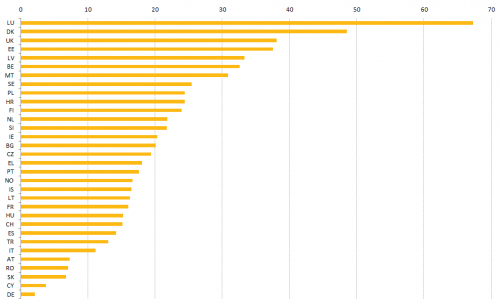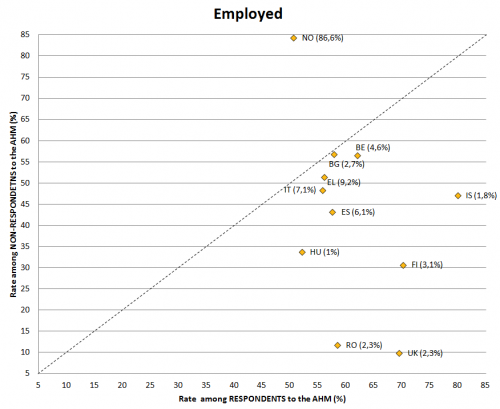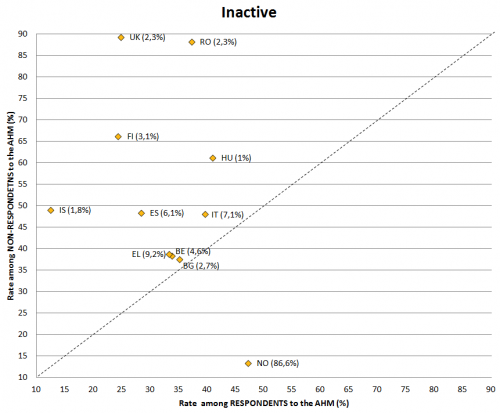Disability statistics background - Labour force survey - non-response analysis
This article looks at the participation in the 2011 EU Labour force survey (LFS) ad-hoc module. It was designed to gather information on the situation of people with disabilities in the labour market in general and in comparison with everyone else. This ad-hoc module was carried out in 32 countries: the EU-28 Member States plus Turkey, Iceland, Norway and Switzerland. It is part of the online publication on disability.
Full article
Non-response rates
There were cases of non-response for both the core labour force survey and the ad-hoc module. It is difficult to compare these 2 types of non-response. This is partly because of differences in national methods for calculating the non-response rate for the core labour force survey, and partly because of differences in target population. The module was aimed at people aged 15-64, whereas the target population for the core labour force survey covers a wider age range which varies by country. It is also important to note that countries do not necessarily collect ad-hoc module data using the entire annual labour force survey sample.
Non-response to the core Labour force survey
The countries participating in the survey provided data on non-response to the core LFS [1]. The non-response rate for the core LFS varied in 2011 from 2.1% in Germany to 67.3% in Luxembourg (Figure 1). The EU Quality Report[2] found that it is not possible to compare the non-response rates of different countries as some calculations apply to households and others to individuals. In addition, for some countries the non-response rate calculated using microdata (information about the people who responded to the survey) differs from the rate cited in national quality reports.
Non-response to the ad-hoc module
The non-response for the 2011 LFS ad-hoc module refers to people who responded to the core survey and were aged 15-64[3]. People were classified as non-respondent if they did not state whether they:
- had any longstanding health condition or disease or any basic activity difficulty, and
- had a work limitation (number of hours, type, getting to and from work) that is not caused by a longstanding health condition or basic activity difficulty and
- required special assistance at work (personal assistance, workplace adaptations, special working arrangements).
Non-response to the ad-hoc module varied widely between countries (Figure 2). 12 answered in full. In all other countries, the non-response rate was below 10 %, except in Norway, where it was 87 %. Norway’s unusually high rate was caused by a filter question added at the start of the module.
Only 7 countries listed the causes of non-response, which varied considerably. In France, the main reason for non-response was that interviewers had not been able to reach the person. But in Finland, 50 % of non-responses were a result of the respondent being unable to answer the question or a disagreement over the answer.
Non-response bias
Where countries had a non-response rate above 1 % for the 2011 ad-hoc module (among those people who had completed the core survey), the background variables were analysed. The countries concerned are Hungary (1.0 % non-response rate), Romania (2.3 %), the United Kingdom (2.3 %), Bulgaria (2.7 %), Finland (3.1 %), Belgium (4.6 %), Spain (6.1 %), Italy (7.1 %), Greece (9.2 %), Iceland (1.8 %) and Norway (86.6 %).
The aim was to find out whether the profile of non-respondents differed from that of respondents. Several variables were studied: marital status, the degree of urbanisation, number of people in the household, gender, age group, labour status, and the highest level of education completed.
For marital status, there were some differences between respondents and non-respondents. In Belgium, Spain, Finland, the UK and Norway, most respondents were married, while most non-respondents were single. In the other countries, married people made up the majority of respondents and non-respondents alike.
A similar pattern emerged for the degree of urbanisation. In Belgium, Spain and the UK, most respondents and non-respondents lived in densely populated areas. In Bulgaria, Greece, Hungary, Romania, Finland and Iceland, however, respondents and non-respondents lived mainly in thinly populated areas.
More respondents lived alone compared with non-respondents, except in Italy and Hungary where the opposite was true.
In some countries, there were marked differences between respondents and non-respondents. In Romania, Finland, the UK and Norway, most non-respondents were men, despite women representing over 50% of total survey respondents.
In Belgium, Spain, the UK, Romania and Norway, non-respondents were younger than respondents. In Italy and Greece, non-respondents were older – a quarter were aged 55-64, while the highest proportion of respondents fell into the 45-54 age category.
With regard to the highest level of education completed, only Finland reported a distinction between the 2 populations; 49 % non-respondents achieved International Standard Classification of Education (ISCED) level 2 at most, whereas 45 % of the respondents completed education levels ISCED 3 and ISCED 4.
Figures 3, 4 and 5 show the distribution patterns of employed people (Figure 3), unemployed people (Figure 4) and economically inactive people (Figure 5) as a proportion of respondents and non-respondents.
People who responded to the ad-hoc module were more likely to be employed than those who did not respond, except in Norway. Indeed, the difference in percentage points varied from 1 % in Bulgaria to 60 % in the UK. Over 50 % of respondents were employed, but fewer non-respondents were employed. In the UK and Romania, for example, only 10 % and 12 % respectively of non-respondents were employed.
The same trend was observed for unemployed people, except in Belgium. Unemployed people represented less than 10 % of both groups, except in Greece and Spain where they represented 11 % and 14 % respectively of respondents.
In contrast to the figures for employed and unemployed people, a higher proportion of non-respondents were economically inactive compared with respondents. In Hungary, Romania, Finland and the UK, most non-respondents were economically inactive.
Partial non-response
This section provides information on people who did not answer all of the questions – partial non-response. The aim is to see if the profile of respondents is different from that of non-respondents, when broken down by specific variables. The variables chosen for this comparative analysis are gender, age, marital status, the degree of urbanisation, the number of people in the household, education level and labour status. The data are based on the countries that carried out the ad-hoc module.
In the analysis that follows, the figures in brackets are the percentage point differences between the respondents and the non-respondents.
Table 1 shows that for the first main type of longstanding health condition or disease (HEALTHMA), 36 % of respondents and 20 % of non-respondents lived in a thinly populated area. The proportion of people from a thinly populated area was therefore higher among respondents than among non-respondents (+16 percentage points). Among respondents, there was a higher proportion of people with a lower secondary educational level (+15 percentage points) and of economically inactive people (+18 percentage points) than among non-respondents. In contrast, there was a lower proportion among respondents of people from an intermediately populated area (-11 percentage points), people with a medium level of education (upper secondary level) (-11 percentage points) and employed people (-22 percentage points) than among non-respondents. There were similar trends for the second main longstanding health condition or illness (HEALTHSE).
Regarding the first basic activity difficulty (DIFFICMA), more respondents than non-respondents fell into the 15-44 age category (+15 percentage points). The opposite was true for the 45 64 age category, where there were fewer respondents than non-respondents (-15 percentage points).
For the second basic activity difficulty (DIFFICSE), there was a higher proportion of the following groups among respondents than non-respondents: people aged 55-64 (+10 percentage points), people from a thinly populated area (+19 percentage points), people with a lower secondary educational level (+18 percentage points), and economically inactive people (+17 percentage points). In parallel, there were lower proportions of the following groups among respondents than non-respondents: people from densely populated areas (-18 percentage points), people with a high level of education (post-secondary) (-10 percentage points) and employed people (-17 percentage points).
Similar trends emerged for the 3 variables relating to health conditions, or illnesses or difficulty(ies) that cause(s) the person’s limitation in the number of hours that he/she can work in a week (LIMHOURS) or the type of work that he/she can do (LIMTYPEW) or in getting to and from work (LIMTRANS). The proportion of people from thinly populated areas and of employed people was higher among respondents than among non-respondents (+16 percentage points and +10 percentage points respectively, on average). Moreover, the proportion of economically inactive people was lower among respondents than among non-respondents ( 11 percentage points, on average).
The same trends emerged for the variables relating to needing or using personal assistance (NEEDHELP), special equipment or workplace adaptations (NEEDADAP), or special working arrangements (NEEDORGA) in order to work. There were higher proportions of people from thinly populated areas and of employed people among respondents than among non-respondents (+9 percentage points and +14 percentage points respectively, on average). Furthermore, the proportions of people from intermediately populated areas and of economically inactive people were lower among respondents than among non-respondents (-10 percentage points and -17 percentage points respectively, on average).
Finally, for the variable on the limitations in work owing to personal or environmental factors (LIMREAS), the proportions of people from intermediately populated areas and of inactive people were lower among respondents than among non-respondents (-12 percentage points and -11 percentage points respectively).
Further methodological information
Direct access to
Online publications
Methodological articles related to 2011 LFS AHM
Notes
- ↑ Labour force survey in the EU, candidate and EFTA countries - Main characteristics of national surveys, 2011
- ↑ Quality Report European Union Labour Force Survey, 2012
- ↑ In the United Kingdom and Spain, questions were answered by a proxy for persons aged 15 years old. Moreover, in Iceland the target population is only 16-64.
[[Category:Health|Disability statistics background - Labour force survey - non-response analysis]





